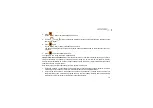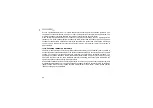
23
14 CONDITION AND PREPARATION OF SURFACES
The shape and roughness of the test surface are of paramount importance when carrying out ultrasonic
thickness testing. Rough, uneven surfaces may limit the penetration of ultrasound through the material, and
result in unstable, and therefore unreliable, measurements.
The surface being measured should be clean, and free of any small particles, rust, or scale. The presence
of such obstructions will prevent the transducer from seating properly against the surface. Often, a wire
brush or scraper will be helpful in cleaning surfaces. In more extreme cases, rotary sanders or grinding
wheels may be used, though care must be taken to prevent surface gouging, which will inhibit proper
transducer coupling.
Extremely rough surfaces, such as the pebble-like finish of some cast iron, will prove most difficult to
measure. These kinds of surfaces act on the sound beam like frosted glass acts on light, the beam becomes
diffused and scattered in all directions.
In addition to posing obstacles to measurement, rough surfaces contribute to excessive wear of the
transducer, particularly in situations where the transducer is ‘scrubbed’ along the surface.




































